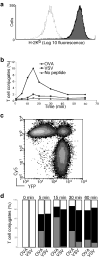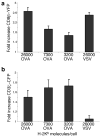Nonstimulatory peptides contribute to antigen-induced CD8-T cell receptor interaction at the immunological synapse
- PMID: 15980863
- PMCID: PMC1352171
- DOI: 10.1038/ni1220
Nonstimulatory peptides contribute to antigen-induced CD8-T cell receptor interaction at the immunological synapse
Abstract
It is unclear if the interaction between CD8 and the T cell receptor (TCR)-CD3 complex is constitutive or antigen induced. Here, fluorescence resonance energy transfer microscopy between fluorescent chimeras of CD3zeta and CD8beta showed that this interaction was induced by antigen recognition in the immunological synapse. Nonstimulatory endogenous or exogenous peptides presented simultaneously with antigenic peptides increased the CD8-TCR interaction. This finding indicates that the interaction between the intracellular regions of a TCR-CD3 complex recognizing its cognate peptide-major histocompatibility complex (MHC) antigen, and CD8 (plus the kinase Lck), is enhanced by a noncognate CD8-MHC interaction. Thus, the interaction of CD8 with a nonstimulatory peptide-MHC complex helps mediate T cell recognition of antigen, improving the coreceptor function of CD8.
Conflict of interest statement
Competing interests statement
The authors declare that they have no competing financial interests.
Figures






Similar articles
-
CD8beta endows CD8 with efficient coreceptor function by coupling T cell receptor/CD3 to raft-associated CD8/p56(lck) complexes.J Exp Med. 2001 Nov 19;194(10):1485-95. doi: 10.1084/jem.194.10.1485. J Exp Med. 2001. PMID: 11714755 Free PMC article.
-
Ligand-engaged TCR is triggered by Lck not associated with CD8 coreceptor.Nat Commun. 2014 Nov 27;5:5624. doi: 10.1038/ncomms6624. Nat Commun. 2014. PMID: 25427562 Free PMC article.
-
Co-receptors and recognition of self at the immunological synapse.Curr Top Microbiol Immunol. 2010;340:171-89. doi: 10.1007/978-3-642-03858-7_9. Curr Top Microbiol Immunol. 2010. PMID: 19960314 Free PMC article. Review.
-
Impact of antigen presentation on TCR modulation and cytokine release: implications for detection and sorting of antigen-specific CD8+ T cells using HLA-A2 wild-type or HLA-A2 mutant tetrameric complexes.J Immunol. 2002 Mar 15;168(6):2766-72. doi: 10.4049/jimmunol.168.6.2766. J Immunol. 2002. PMID: 11884444
-
Mechanistic diversity in MHC class I antigen recognition.Biochem J. 2021 Dec 22;478(24):4187-4202. doi: 10.1042/BCJ20200910. Biochem J. 2021. PMID: 34940832 Free PMC article. Review.
Cited by
-
Assessment of Patient-Specific Human Leukocyte Antigen Genomic Loss at Relapse After Antithymocyte Globulin-Based T-Cell-Replete Haploidentical Hematopoietic Stem Cell Transplant.JAMA Netw Open. 2022 Apr 1;5(4):e226114. doi: 10.1001/jamanetworkopen.2022.6114. JAMA Netw Open. 2022. PMID: 35385089 Free PMC article.
-
Normal T cell homeostasis: the conversion of naive cells into memory-phenotype cells.Nat Immunol. 2011 Jun;12(6):478-84. doi: 10.1038/ni.2018. Nat Immunol. 2011. PMID: 21739670 Free PMC article. Review.
-
Visualization of protein interactions in living cells.Adv Exp Med Biol. 2008;640:183-97. doi: 10.1007/978-0-387-09789-3_14. Adv Exp Med Biol. 2008. PMID: 19065792 Free PMC article. Review.
-
An endogenous positively selecting peptide enhances mature T cell responses and becomes an autoantigen in the absence of microRNA miR-181a.Nat Immunol. 2009 Nov;10(11):1162-9. doi: 10.1038/ni.1797. Epub 2009 Oct 4. Nat Immunol. 2009. PMID: 19801983 Free PMC article.
-
T cell receptor (TCR) signaling in health and disease.Signal Transduct Target Ther. 2021 Dec 13;6(1):412. doi: 10.1038/s41392-021-00823-w. Signal Transduct Target Ther. 2021. PMID: 34897277 Free PMC article. Review.
References
-
- Davis MM, et al. Ligand recognition by αβ T cell receptors. Annu Rev Immunol. 1998;16:523–534. - PubMed
-
- Gascoigne NRJ, Zal T, Alam SM. T-cell receptor binding kinetics in T-cell development and activation. Exp Rev Mol Med. 2001 Feb 12;2001:1–17. ( http://www.expertreviews.org/01002502h.htm) - PubMed
-
- Zamoyska R. CD4 and CD8: Modulators of T-cell receptor recognition of antigen and of immune responses? Curr Opin Immunol. 1998;10:82–87. - PubMed
-
- Potter TA, Rajan TV, Dick RF, 2nd, Bluestone JA. Substitution at residue 227 of H-2 class I molecules abrogates recognition by CD8-dependent, but not CD8-independent, cytotoxic T lymphocytes. Nature. 1989;337:73–75. - PubMed
Publication types
MeSH terms
Substances
Grants and funding
LinkOut - more resources
Full Text Sources
Other Literature Sources
Molecular Biology Databases
Research Materials
Miscellaneous
